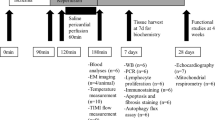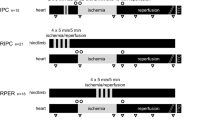Abstract
Heat shock has been shown to increase the cellular tolerances to ischemic injury. In this study, we examined the effects of heat shock induced by amphetamine on postischemic myocardial functional recovery in a setting of coronary revascularization for acute myocardial infarction. Intramuscular injection of amphetamine (3 mg/kg, i.m.) to pigs increased the body temperature to 42.5°C within 1 h, and maintained this temperature for an additional 2 h. Fourty h after the amphetamine injection, the pigs were placed on by cardiopulmonary bypass and then isolated,in situ heart preparations were subjected to 1 h of global hypothermic cardioplegic arrest and 1 h of normothermic reperfusion. Postischemic myocardial performance was monitored by measuring left ventricular (LV) pressure, its dp/dt, myocardial segmental shortening (%SS), and coronary blood flow. Cellular injury was examined by measuring creatine kinase (CK) release. Biochemical measurements included quantification of plasma catecholamines and study of the induction of heat shock gene expression and antioxidative enzymes in the heart tissue. The results of this study indicated significantly greater recovery of LV contractile functions by amphetamine as demonstrated by improved recovery of LVDP (61% vs 52%), dp/dtmax (52% vs 44%), and segmental shortening (46.2% vs 10%). Myocardial CK release was significantly reduced in the amphetamine group. Furthermore, amphetamine pretreatment was associated with the induction of heat shock protein (HSP) 27 mRNA and stimulated Cu/Zn-superoxide dismutase and catalase levels, suggesting that amphetamine mediated improved postischemic ventricular recovery might be linked with its ability to induce heat shock and stimulate antioxidant enzymes.
Similar content being viewed by others
References
Burdon RH: Heat shock and heat shock proteins Biochem J 240: 313–324, 1986
Subjeck JR, Shyy TT: Stress protein systems of mammalian cells. Am J Physiol 250: C1-C17, 1986
Lindquist S: The heat shock response Annu Rev Biochem 55: 1151–1191, 1986
Hightower LE: Heat shock, stress proteins, chaperones, and proteotoxicity. Cell 66: 191–197, 1991
Morimoto RI, Tissieres A, Geogopoulos C: Stress Proteins in Biology and Medicine. Cold Spring Harbor Laboratory Press, 1990, pp 1–36
Cairo G, Bardella L, Schiaffonati, Bernell-zazzer A: Synthesis of heat shock proteins in rat liver after ischemia and hyperthermia. Hepatology 5: 357–361, 1985
Currie RW: Synthesis of stress-induced proteins in isolated and perfused rat hearts. Biochem Cell Biol 64: 418–426, 1986
Currie RW, Karmazyn M, Kloc M, Mailer K: Heat shock response is associated with enhanced postischemic ventricular recovery. Circ Res 63: 543–549, 1988
Perdrizet GA, Heffron TG, Buckingham FC, Salciunas PJ, Gaber AO, Stuart FP, Thistlethwaite JR: Stress conditioning: A novel approach to organ preservation. Cur Surg 46: 23–26, 1989
Liu X, Engelman RM, Moraru II, Rousou JA, Flack III JE, Deaton DW, Maulik N, Das DK: Heat shock: A new approach for myocardial preservation in cardiac surgery. Circulation 86 (supp II): 358—363, 1992
Otani H, Engelman RM, Rousou JA, Breyer RH, Clement R, Prasad R, Klar J, Das DK: Improvement of myocardial function by trifluoperazine, a calmodulin antagonist, after acute coronary artery occlusion and coronary revascularization. J Thorac Cardiovasc Surg 97: 267–276, 1989
Das DK, Engelman RM, Kimura Y: Molecular adaptation of cellular defences following preconditioning of the heart by repeated ischemia. Cardiovasc Res 27: 578–584,1993
Lu D, Maulik N, Moraru II, Kreutzer DL, Das DK: Molecular adaptation of vascular endothelial cells to oxidative stress. Am J Physiol (Cell) 264: C715-C722, 1993
Axelord J, Tomchick R: Increased rate of metabolism of epinephrine and norepinephrine by sympathomimetic amines. J Pharmacol Exp Therapeu 130: 367–374, 1960
Weiss B: Enhancement of performance by amphetamine like drugs. In: T. Sjoquist and M. Tohie (eds). Abuse of Central Stimulants. New York, Raven Press, 1969, pp 31–60
Lu D, Das DK: Induction of differential heatshock gene expression in heart, lung, liver, brain and kidney by a sympathomimetic drug, amphetamine. Biochem Biophys Res Commun 192: 808–812, 1993
Nowak TS, Bond U, Schlesinger MJ: Heat shock RNA levels in brain and other tissues after hyperthermia and transient ischemia. J Neurochem 54: 451–458, 1990
Locke-Winter CR, Winter CB, Nelson DW, Banerjee A: cAMP stimulation facilitates preconditioning against ischemia-reperfusion through norepinephrine and α1 mechanisms. Circulation 84 (suppl II): 433–438, 1991
Knowlton AA, Brecher P, Apstein CS: Rapid expression of heat shock protein in the rabbit after brief cardiac ischemia J Clin Invest 87: 139–147, 1991
Donnelly TJ, Sievers RE, Vissern FLJ, Welch WJ, Wolfe CL: Heat shock protein induction in rat hearts: A role for improved myocardial salvage after ischemia and reperfusion? Circulation 85: 769–778, 1992
Wall SR, Fliss H, Kako KJ, Korecky B: Heat shock does not improve recovery of function after no-flow ischemia in isolated rat hearts. J Mol Cell Cardiol 22 (suppl I): 44, 1990
Yellon DM, Iliodromitis E, Latchman DS, Van Winkle DM, Downey JM, Williams FM, Williams TJ: Whole body heat stress fails to limit infarct size in the reperfused rabbit heart. Cardiovasc Res 26: 342–346, 1992
Salo D, Donovan CM, Davies KJA: HSP 70 and other possible heat shock oxidative stress proteins are induced in skeletal muscle, heart, and liver during exercise. Free Rad Biol Med 11: 239–246, 1991
Currie RW, Tanguay RM: Analysis of RNA for transcripts for catalase and SP 71 in rat hearts afterin vivo hyperthermia. Biochem Cell Biol 69: 375–382, 1991
Karmazyn M, Mailer K, Currie RW: Acquisition and decay of enhanced post-ischemic ventricular recovery is associated with the heat shock response. Am J Physiol 259: H424–431, 1990
Shedt CA, Hass MA, Massaro D:In vitro heat shock increases the synthesis of Cu−Zn superoxide dismutase in normal mammalian tissue. Proc Fed Am Soc Exp Biol 45: 317–325, 1986
Polla BS: A role for heat shock proteins in inflammation? Immunol Today 9: 134–137, 1988
Das DK, Engelman RM: Mechanism of free radical generation in ischemic and reperfused myocardium. In: D.K. Das, W.B. Essman (ed). Oxygen Radicals: Systemic Events and Disease Processes. CRC Press, Florida, 1989, pp 97–128
Kukreja RC, Hess ML: Oxygen radicals, neutrophil-derived oxidants, and myocardial reperfusion injury. In: D.K. Das (ed). Pathophysiology of reperfusion injury. CRC Press, Florida, 1993, pp 221–242
Author information
Authors and Affiliations
Rights and permissions
About this article
Cite this article
Maulik, N., Wei, Z., Liu, X. et al. Improved postischemic ventricular functional recovery by amphetamine is linked with its ability to induce heat shock. Mol Cell Biochem 137, 17–24 (1994). https://doi.org/10.1007/BF00926035
Received:
Accepted:
Issue Date:
DOI: https://doi.org/10.1007/BF00926035




